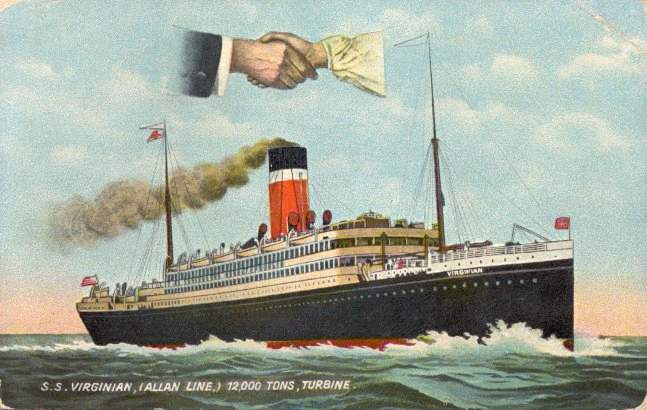Relationship to Titanic disaster / inquiries.
April 15, 1912
Eastbound, Halifax to Liverpool. At 12:40 a.m., picked up distress call from Titanic by way of Cape Race (MCE). Immediately tuned in to Titanic and passed on details of the disaster to other ships. Although she was 178 miles to the north, was erroneously reported to have Titanic in tow.
Data:
Virginian had a long and industrious career. She performed faithfully for several employers, serving as a troop carrier in the Great War and as a Red Cross repatriation vessel during the Second World War.
The maiden voyage of her sister ship Victorian in March 1905 marked the entry of turbine power to the North Atlantic. And while Victorian was scrapped in 1929, Virginian was in active service until 1954.
December 22, 1904
Launched.
April 6, 1905
Maiden voyage, Liverpool-St. John, New Brunswick. Subsequent trips between Liverpool and Montreal.
August 1914
Troop ship for Canadian Expeditionary Force.
November 13, 1914
Requisitioned as armed merchant cruiser, 10th Cruiser Squadron.
July 16, 1917
Allan Line absorbed by Canadian Pacific Ocean Services. Virginian remained in service as an armed merchant cruiser.
December 1917
Paid off by British Admiralty; taken up by the Liner Requisition Scheme.
December 23, 1918
Taken to Glasgow for complete refitting.
January 31, 1920
Released to Canadian Pacific Line, but did not sail for them.
February 14, 1920
Sold to Swedish American Line; renamed Drottningholm.
May 1920
First voyage for Swedish American Line, Gothenburg-New York.
1922
Engines refitted: new single-reduction geared turbines, oil fuel. Accommodation: cabin 532;
third 854.
1923-1939
Gothenburg-New York service.
1939-1945
Used by International Red Cross in prisoner-of-war and refugee repatriation.
March 1946
Resumed Sweden-New York passenger service, the first of any post-war commercial service.
March 1948
440th and last crossing for Swedish American Line. Transferred to Home Lines under Panamanian flag; renamed Brasil.
Spring 1950
First voyage, Naples-New York (Five return voyages).
June 16, 1951
Renamed Homeland. First voyage Hamburg-Southampton-Halifax-New York. Accommodation: First 96; tourist 846.
Spring 1952
Genoa-Naples-New York.
| 
